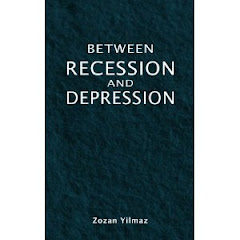Finance theory categorises investors’ attitudes to risk under three headings as risk averse, risk neutral and risk lover. The first is where investor prefers less risk to more, second where investor is indifferent to risk and finally the third where investors prefer more risk for less.
Conventional wisdom is that investors are risk averse. The higher the risk they associate with a particular investment, the higher the return they will demand. According to portfolio theory, the main risk investors will ask return for is the systematic/market risk, which is the part that can not be removed through diversification and measured by beta. – The correlation of any stock’s return with the market-
During the last three decades of boom period, we breached this wisdom by taking risks beyond the capacity funded by debt assuming the bull market will go on. The result is well known as a global financial system brought to the edge of collapse.
Now we are all risk averse. UK government’s failed bond auction on 25th March is the evidence of how dramatically risk averse we have been. Germany had the same painful experience earlier this year. We are used to experience this with emerging markets but when it is the world’s 5th and 4th largest economies respectively you are talking about, then you stop and think.
The investors’ concern is understandable when you look at the facts that planned UK government borrowing of £350 billion for financial years of 2009-10 & 2010-11 is GREATER than total borrowed by successive rulings and governments of Britain between 1691 and 1997. Mervyn King’s loud concern makes more sense after taking this fact into consideration.
The yield on the 10-year UK Gilt climbed 7bp to 3.02 per cent in the third week of March 2009. A sign that investors are nervous about buying UK government debt and asking for premium for the perceived risk
Is there another option? Domestic demand is contracting mainly by consumption and investment items of GDP. Government item needs to increase its share to fill the big hole left from the former two and borrowing is the only funding option.
Monetary policy is already in place with bank rates near zero. Four million tracker mortgages will enjoy reduction in the mortgages they pay, if not yet so and hopefully this will boost consumption. Low interest rates should theoretically cause investment to increase but the current climate is making this item most difficult to play its role given the reluctance of the banks to lend, uncertainty surrounding the global economy, spare capacity. Another barrier for private investment item is the crowding effect created by the government borrowing.
But there is no solution to keep all sides happy. One or more sides have to pay for the cost. In this instance it seems to be partly private investment in lack of fund, depressed demand and government in having to bailout the private sector.
Let’s hope these efforts give fruits soon.
Friday 27 March 2009
Sunday 22 March 2009
WINNING STRATEGY: COST LEADERSHIP
WINNING STRATEGY: COST LEADERSHIP
Anyone who has somehow touched business studies will recall Michael Porter’s name. Porter -Harvard professor specialising in Management and Economics - describes three generic strategies of firms to gain competitive advantage as: cost leadership, differentiation and market segmentation or focus.
Differentiation has been an innovative and respectable way of entering to and staying in any market of which doing the business in a different way, challenging the available methods, thinking outside the box have been the main characteristics. However credit crunch is making it hard for differentiation to breath and pushing firms in most industries to be cost leader to increase their market share or in most cases to survive.
Swiss chocolate maker Lindt & Sprungli’s closure of 62.5 per cent of its 80 retail boutiques in US is the most recent example of this. Lindt has a self defined philosophy of premium quality chocolate with products or services of superior quality and value and a history, which goes back to 1879. Being established and good quality can not prevent customers from moving to cheaper brands.
Asda and Lidl’s increase in UK market share by the end of 2008 due to cheap products are other examples of success of the strategy in retail sector.
The problem with cost leadership is the squeezing profit margins, thanks to price sensitive buyers, which is a barrier to new entrants. However it will work well when there are economies of scale, learning effect, low costs for factors of production, technological developments.
If you can achieve these conditions adding minimum or best no debt in balance sheet, then you are likely to be a winner.
Anyone who has somehow touched business studies will recall Michael Porter’s name. Porter -Harvard professor specialising in Management and Economics - describes three generic strategies of firms to gain competitive advantage as: cost leadership, differentiation and market segmentation or focus.
Differentiation has been an innovative and respectable way of entering to and staying in any market of which doing the business in a different way, challenging the available methods, thinking outside the box have been the main characteristics. However credit crunch is making it hard for differentiation to breath and pushing firms in most industries to be cost leader to increase their market share or in most cases to survive.
Swiss chocolate maker Lindt & Sprungli’s closure of 62.5 per cent of its 80 retail boutiques in US is the most recent example of this. Lindt has a self defined philosophy of premium quality chocolate with products or services of superior quality and value and a history, which goes back to 1879. Being established and good quality can not prevent customers from moving to cheaper brands.
Asda and Lidl’s increase in UK market share by the end of 2008 due to cheap products are other examples of success of the strategy in retail sector.
The problem with cost leadership is the squeezing profit margins, thanks to price sensitive buyers, which is a barrier to new entrants. However it will work well when there are economies of scale, learning effect, low costs for factors of production, technological developments.
If you can achieve these conditions adding minimum or best no debt in balance sheet, then you are likely to be a winner.
Thursday 19 March 2009
RECESSION AND NUMBERS
As the recession gets deeper and eyes are on the G20 meeting to be held in April 2009, numbers still manage to surprise with one record after another.
Let’s look at some recent unforgettable figures;
On micro basis;
Fedex reported 75 per cent fall in profits on19th March 2009 for its quarter ending on 28th February 2009 from $393 million to $97 million.
AIG reported $60 billion loss for Q4-08, the biggest in US corporate history.
HSBC had £12.5 billion rights issue
Macro basis;
Japan’s exports fell by 45.7%, German engineering companies’ export orders by 47 per cent in January 2009. 700,000 US job losses were recorded in February 2009.
The changes are very high in percentage and absolute figures when the shortness of the periods is taken into consideration.
The picture gets gloomier when adding the major stock markets’ significantly lost values such that;
Dow Jones industrial average fell to its lowest level since 1997 with 22 per cent loss since the start of 2009 -as of 2nd March 2009- accompanied by S & P 500’s 21 per cent fall.
Q1-09 figures will be very crucial in managing expectations. So far so bad!
Let’s look at some recent unforgettable figures;
On micro basis;
Fedex reported 75 per cent fall in profits on19th March 2009 for its quarter ending on 28th February 2009 from $393 million to $97 million.
AIG reported $60 billion loss for Q4-08, the biggest in US corporate history.
HSBC had £12.5 billion rights issue
Macro basis;
Japan’s exports fell by 45.7%, German engineering companies’ export orders by 47 per cent in January 2009. 700,000 US job losses were recorded in February 2009.
The changes are very high in percentage and absolute figures when the shortness of the periods is taken into consideration.
The picture gets gloomier when adding the major stock markets’ significantly lost values such that;
Dow Jones industrial average fell to its lowest level since 1997 with 22 per cent loss since the start of 2009 -as of 2nd March 2009- accompanied by S & P 500’s 21 per cent fall.
Q1-09 figures will be very crucial in managing expectations. So far so bad!
Subscribe to:
Posts (Atom)


